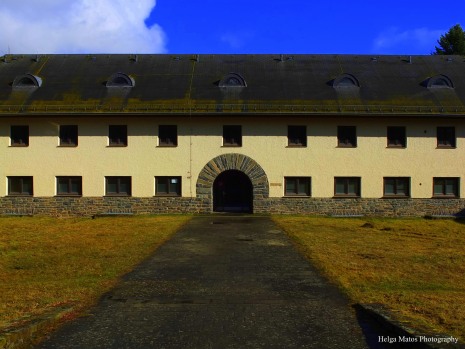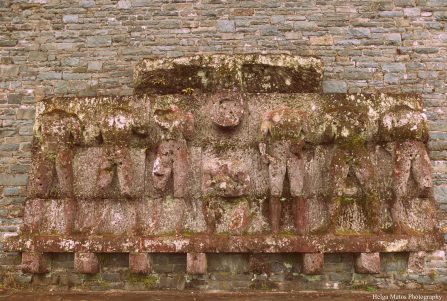Yesterday was another day meant to visit some site within NRW. My choice was Vogelsang IP. I already came to know about it time ago and it was in my “must see” list. Me and my friend Ankit caught a bus from Aachen and on our way it started to rain. My friend kept saying that it would keep raining because it happens whenever he plans a trip (he finds himself very special) But just to contradict him, I bet with him that if the sun comes out (keep positive thinking), I should get a present from him. It was a risk because to be honest I didn’t have the single clue that the weather would improve. However, as soon as we arrived there, the sun comes out and the previous grey and rainy sky was gone. I couldn’t contain myself of joy. And my friend end up cooking the dinner for us both, without me doing a thing!
So you might be wondering, what is Vogelsang IP and what’s so particular about it? Well, for start it is located in a hill in the middle of the Eifel National Park, with an astonishing view to the river, but Vogelsang ip is an historical complex constructed in 1934 by the National Socialists for training of their future political leaders. From 1946 to 2005 it was centre of initially a British and later a Belgian military training ground. Nowadays is an international place of active remembrance, with a new “Forum Vorlesang” currently in construction, funded by European Union and with opening preview to 2005.
We started our tour picking up a flyer with main points’ indications throughout the complex. In each there are information boards with old photos and some historical facts. All the historical facts that I will write here are taken from those boards and all the photos are from my authorship.
1) Belgian Barracks “Van Dooren”: constructed bt the Belgian military
And because little details does matter, this little kid in his tiny bicycle crawling his feet along the downhill was amusing. Family trip to Vogelsang where the kids are playing around couldn’t be healthier. But with the slop that is needed to reach the complex’ bottom, rollerblading are not the right choice!
2) “Burgschänke” viepoint and start of the circular trail
3) Former Hospital
“The building was constructed to provide residential accommodation for the female staff at Vogelsang who did not live in the region.
A year after its completion, the German Labor front established an infirmary here with a “castle doctor” and nursing staff. In 1941, this sick bay was turned into a general hospital with 32 beds, against the wishes of the district medical authorities, to which above all women from large towns endangered by bombing were admitted. This led to inaccurate rumors to the effects that there was a branch of the SS association “Lebensboln e.V” for “breeding” “Arian” offspring at Vogelsang.
Unlike the other buildings at Vogelsang, the main section of the building is not faced with natural stone, but is plastered and painted, resulting in a more modern and lighter effect.
The Belgian military forces, who termed the building “Redoute”, used it as accommodation for officers.“
4) “Fackelträger”
“A six-metre block of wall with a receptacle for fire was erected here. An athletic, naked torch-bearer defying a storm is depicted on the front of the block. The figure takes it stylistic orientation from the monumental sculptures produced for the Olympic Games in 1936 at the Reich Sports Field in Berlin.
The inscription reads: “You are the torch-bearers of the nation. You carry the light of the spirit forward in the battle for Adolf Hitler.” The sculpture and the text expressed Vogelsang’s purpose in no uncertain terms: the development of aloyal, physically impressive and ideologically resolute group of Naional Socialist fighters.
Meller’s relief is one of many larger-than-life sculptures from the Third Reich in which artists who conformed to the system dealt thematically with the racist ideal of a master race in National Socialism.”
5) Kameradschaftshäuser
“Ten residential buildings were built on three newly-created terraces in 1934/1935. These were called “Kameradschaftshäuser”. Clemens Kolz conceived this area as an ensemble of separate structures, the buildings being connected to each other by paths and steps and surrounded by an artistic landscape of grass spaces, walled flowerbeds, bushes and trees. This concept was inspired by hospitals and medical institutions. The buildings were divided into two storeys on the inside. The upper floor contained two dormitories for 20 people and recreation rooms while the ground floor housed a study and sanitary installations. Two of the “Kameradschaftshäuser” were destroyed by bombs at the end of the war. The remaining eight were refurbished by the Belgian military administration and used as accommodation for soldiers.”
6) Former Sports Facilities
“The racist-heroic human ideal propagated by the National Socialists combined physical attributes such as health, strength and beauty with character values such as asceticism, toughness and tearlessness. As most of the desired characteristics could be developed through sport, physical activities played a dominant role on the curriculum at Vogelsang. Almost all the usual types of sports were practiced. Sport facilities were thus fundamental element of training institution. A sports ground with a running track, a 25-metre indoor swimming pool, a gymnasium and a shooting range were constructed from 1935. Over the years, paths, steps, ramps, terraces, open spaces and areas of grass were built into the slope beneath the “kameradschatshäuser”. As a result, the complex expanded downwards towards the lake.”
In the next image (you can see in a bigger plan at the middle of the rectangular of the previous photo), “depicts seven athletes from various sporting disciplines (shotput, javelin, discus, football, relay race, boxing and hammer throw) beneath the wings of the “party eagle”. Soldiers from occupying forces took shots at the relief, which is now extremely weather-worn”
and the actual state of those statues is this:
The inside gable wall of the swimming pool building is dominated by three naked athletes striding through sea surf in dramatic pose. The most surprising is that is still functioning!
7) “Thinstätte”
“The open-air theatre built into the northern slope was used for musical and theatre performance as well as for cerimonies.”












